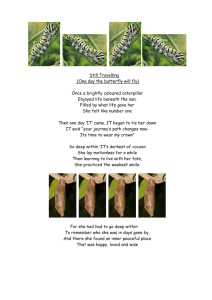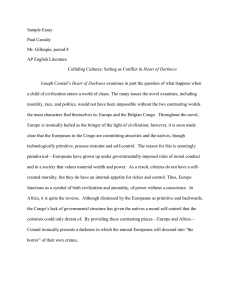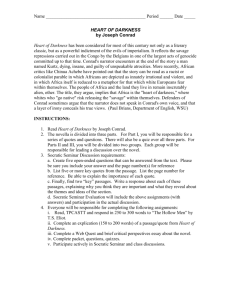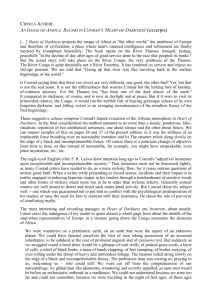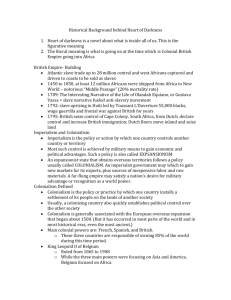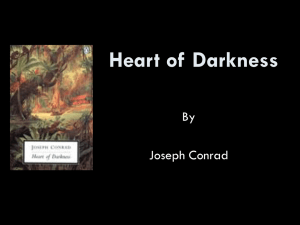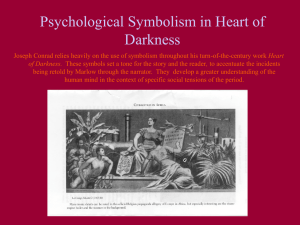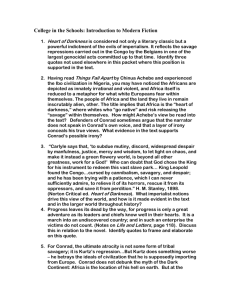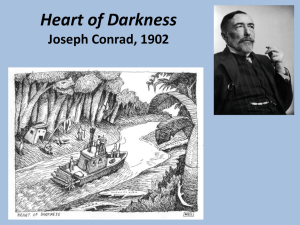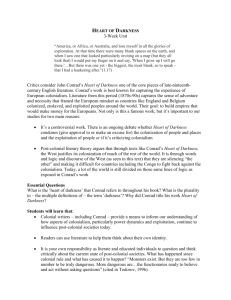Notes on Heart of Darkness and Modernism
advertisement
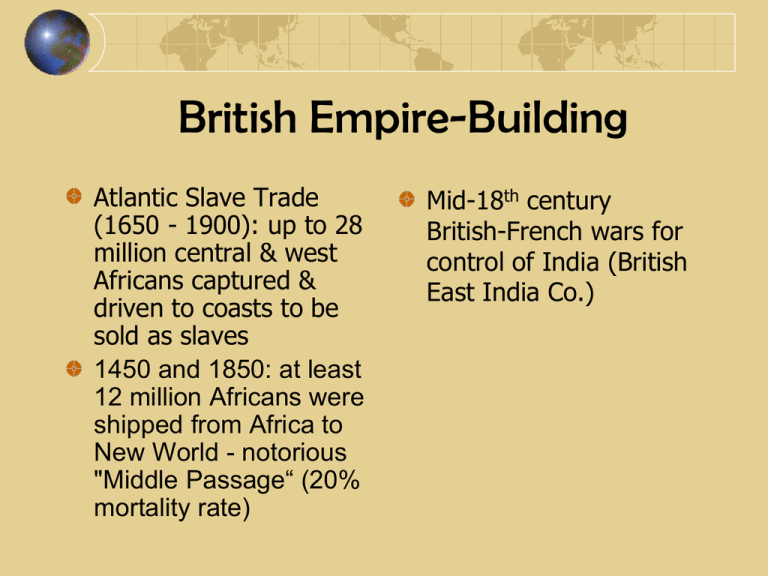
British Empire-Building Atlantic Slave Trade (1650 - 1900): up to 28 million central & west Africans captured & driven to coasts to be sold as slaves 1450 and 1850: at least 12 million Africans were shipped from Africa to New World - notorious "Middle Passage“ (20% mortality rate) Mid-18th century British-French wars for control of India (British East India Co.) British Empire-Building 1789: The Interesting Narrative of the Life of Olaudah Equiano, or Gustava Vassa = slave narrative fuels antislavery movement 1792: Slave uprising in Haiti led by Toussant L'Ouverture 55,000 blacks,wage guerrilla & frontal war against British for years 1795 - 1818: British seize control of Cape Colony, South Africa, from Dutch, declare control & increase Brit. immigration; Dutch Boers move inland & seize land Abolition & Colonization 1833: British abolish slavery in West Indies. 1839-1842: Amistad revolt (basis of 1997 Spielberg film) launches intense legal, political, popular debate over slavery in U.S. 1857-1858: Sepoy “Mutiny” – British Crown takes over India 1863: Emancipation of slaves in U.S. amid Civil War. 1876-77: Queen Victoria declared Empress of India Exploration & Colonization 18th and 19th centuries: European political, economic, scientific interests fuel search for new markets & exploration Stage set for European “Scramble for Africa” – 1870s 1770: James Bruce (Brit.) reaches source of Blue Nile 1795 & 1805: Mungo Park (Scot.) explores Niger River 1855: David Livingstone (Scot.) explores Zambezi River & names Victoria Falls Exploration, Imperialism & Racism 1863: British explorers Speke & James Augustus Grant, traveling downstream, & Sir Samuel White Baker, working upstream, locate sources of Nile Christian missionaries & European merchants come with European explorers View of Africans: "primitive, pre-literate, undeveloped” a/c Eurocentric theories of evolution of civilized culture. Marlow’s & Conrad’s 1889-90 journey into “Heart of Darkness” Joseph Conrad (1857-1914) Early Modernism & Heart of Darkness Social breakdown, fragmentation: lose faith in progress, science, religion, politics, bourgeois morality Alienation from urban bureaucratic society, a sterile, materialistic “waste land” Question, challenge structures of human life--e.g. Christianitychallenged as “convenient fictions” created to impose order, meaning on random, senseless, violent world Personal & Collective Crisis Mid-1870s “Scramble for Africa” 1876-1884: King Leopold II (r. Belgium, 1865-1909) uses Stanley to explore, acquire, colonize “Congo Free State” as his personal possession 1885 Berlin Conference European powers divide up Africa 1889-90: Conrad goes to Congo & captains river steamboat to retrieve Klein; trauma & illness haunt him the rest of his life Heart of Darkness = Harrowing Critique of Western Colonialism 1899, 1902: Heart of Darkness exposes predatory European Colonialism & its atrocities Brussels = “whited sepulchre”; hypocrisy of hollow ideals: “civilizing mission” & “White Man’s Burden Public opinion turns against “jingoism” (e.g Rudyard Kipling) 1908: Leopold II loses Congo to Belgian government 1960: Belgian Congo achieves independence Mythic Journey Unsettling global correspondences in world “myths” & rituals: e.g. Frazer’s Golden Bough: A Study in Comparative Religion (1890) & Weston’s From Ritual to Romance (Fisher king) Carl Jung (1875-1961): all humans share common spiritual/ psychic heritage: collective unconscious, racial memories, archetypes emerge in dreams, myth/religion, art & literature “Psychological” Novel Freud (1856-1939): feeling, unconscious, inward journey into self, back into past/ childhood keys to understanding human nature/behavior Psychoanalytical method: healing through storytelling Focus: mental life, perceptions of story teller and his search for meaning (vs. tale itself) inward journey into dream/nightmare world of irrational “uncontrollable” unconscious Experimental Forms for Multiple “Realities” of Uncertainty flow of consciousness & memory structures narrative: associative (vs. linear) “logic” intertwines present awareness & memory Interior monologue, “stream of consciousness, flashforward/ flash-back Narrative frame-cf. WH Marlow’s 1st-person “limited” narration: discontinuous/fragment ed,suggestive/evocative a-rational connections, introspective Challenges for Readers Narrator/author suggests/evokes, does not explain; personal symbol system new, previously forbidden subjects unsettle readers’ expectations; shock out of complacency Open-ended, ironic, multi-layered, “inconclusive” Process/search/journey meaningful in itself (even if goal never reached) Reader must be active co-creator of meaning: “emplot” life The “Contract” Audience must agree to “play” the imaginative game (“suspend disbelief”) Atwood: “...your life as the writer of each particular story is only as long, and as good, as the story itself.” The “speaking voice” mediates readerlistener’s access to the story, but it is … “double-voiced” dialogue (Bakhtin) between teller & listener each with active roles in making meaning. Genre Theory (> Aristotle) Genre (>French): a type of literary work with defining conventions & audience expectations Genres develop in response to particular cultural, communication, & creative situations Literary genres evolve like social institutions: their conventions/codes emerge, develop, & change over time, reflecting the (changing) values, imagination, spirit of an age, culture, artist Genre History: Dialogues with Tradition “Once you start making...rules, some writer will be sure to happen along and break every abstract rule you or anyone else ever thought up, and take your breath away in the process. The word should is… dangerous. …It’s a kind of challenge to the deviousness and inventive-ness and audacity and perversity of the creative spirit” --Margaret Atwood “High” Modernism Early 20th century – Post -WW I Decline of West: Catastrophe of WWI shook faith in Western civilization & its cultural values Radical break from traditional structures of Western culture & art Artists sought new forms to render contemporary disorder & alienation Difference between Realism and Modernism Whereas REALISM Emphasized absolutism, and Believed that a single reality could be determined through the observation of nature MODERNISM Argued for cultural relativism, And believed that people make their own meaning in the world. Value Differences in the Modern World Pre-Modern World Modern World (Early 20th Century) Ordered Chaotic Meaningful Futile Optimistic Pessimistic Stable Fluctuating Faith Loss of faith Morality/Values Collapse of Morality/Values Clear Sense of Identity Confused Sense of Identity and Place in the World Why the Blurriness? For modern novelists, the messiness, confusion, and darkness of the human experience is interesting. Rather than trying to simplify and abstract a particular meaning from experience, novelists tend to wallow in the multiplicity of ideas and meanings and sensations that experience can provide. Why the Blurriness? Novelists are in the business of recreating and communicating the rich complexities of the experience itself. Their purpose is to get the reader to re-live an experience, with all its complexity and messiness, all its darkness and ambiguity
